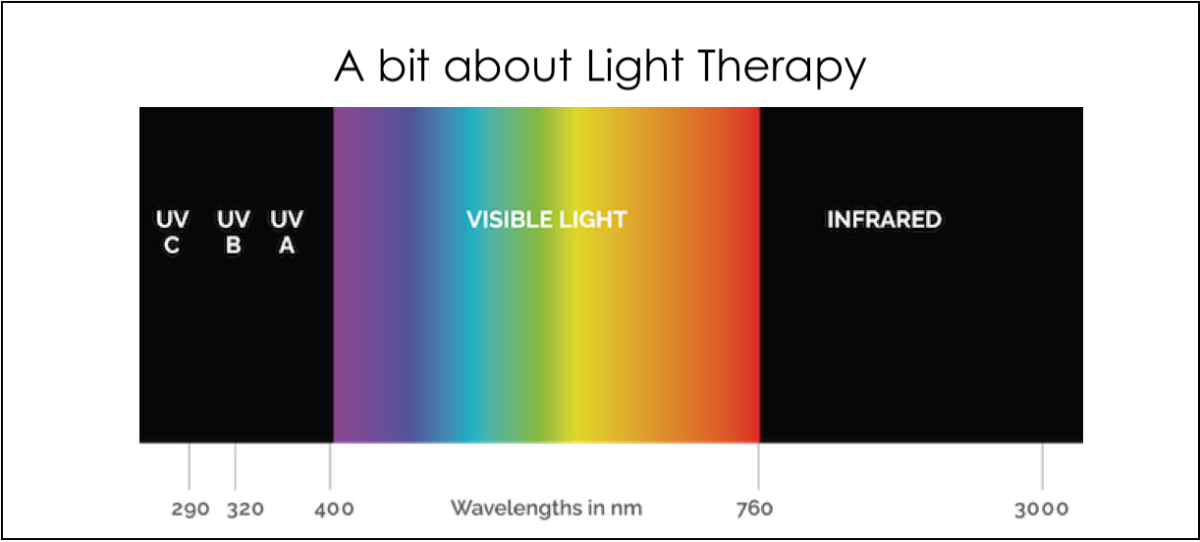Today’s post is about light therapy.
In the past couple of years, red light therapy including infrared saunas and LED light masks have been in the media. These different light treatments are meant to help us with everything from wrinkles to back pain.
We decided to research these different light treatments and see if they are worth the hype.
For ideal health, we humans require regular exposure to light! A great example is Vitamin D which comes from sunlight. The sun’s rays include the more commonly known ultraviolet light (UV), but more than half of its output is infrared. When it comes to visible light, violet coloured light produces the most energy and red coloured light provides the least.
So, what is red light therapy
Red light therapy involves having low-power red light wavelengths emitted directly through the skin, although this process cannot be felt and isn’t painful because it doesn’t produce any heat. Red light can be absorbed into the skin to a depth of about eight to 10 millimetres, at which point it has positive effects on cellular energy and multiple nervous system and metabolic processes.
Through emitting red, low-light wavelengths through the skin, red light therapy may naturally jump-start the process of tissue recovery and other forms of rejuvenation. It’s believed to work in such ways as increasing blood flow and stimulating collagen production.
Clinical studies show that red light therapies have certain healing capabilities and medical applications, due to the way they positively affect the human endocrine and immune systems.
There are many different types of red-light therapy devices, some of which can be used at home. But home devices are usually less powerful than those used in clinics and may be less effective or take longer to work.
What about an infrared (IR)sauna?
This type of sauna uses a different kind of red light.
Infrared light is invisible and is effective for use on the surface of the skin as well as penetration of about 1.5 inches into the body. The wavelength infrared puts out is longer than the wavelength of red light, which allows it to penetrate more deeply into the body.
The longer the wavelength, the deeper the penetration. Consequently, IR light provides some similar, but some completely different benefits than red light.
An infrared sauna is a type of sauna that uses light to make heat. A regular sauna uses heat to warm the air, which in turn warms your body. An infrared sauna heats your body directly without warming the air around you. It is safe because all humans produce IR and it is easily absorbed by our tissues.
When IR enters the body, it breaks up fats and toxins that are trapped in water molecules, it makes us sweat to let them out.
And LED light masks
Light-emitting diodes (LEDs) lights have been around since the 1960s but have only recently been used as a skin treatment.
Using the LED technology to create light weight masks enables people to use light therapy in the home. However, these are not medical-grade products. They aren’t as strong, so while there is some benefit, there won’t be the same result as a professional treatment.
The masks use different wavelengths of the visible light spectrum to penetrate the skin to different depths. Depending on how deeply they penetrate, will determine which of the skin’s natural healing processes are triggered.
Red and blue lights are typically used in LED skin treatments. Experts believe that red LED light acts on cells in the skin known as fibroblasts, which play a role in production of collagen. Blue LED light is most often used to treat acne.
According to research, LED light therapy has an excellent safety profile. It does not contain UV rays, which can be harmful to the skin.
Unlike chemical peels or laser therapy, LED light therapy does not cause burns. Therefore, LED therapy is considered suitable for regular use. Which is important, as usually several treatments are necessary to see results.
However, more research is needed to confirm that these lights are truly effective and that they produce lasting results.
Hopefully you have found this information interesting.
Till the next post,
Live clean n prosper
Sources – National Library of Medicine – Harvard Health Publishing – Mayo Clinic – Web MD –

